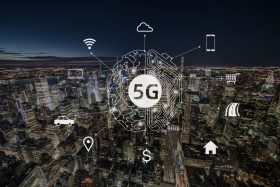AT&T Reveals 5G Edge Zones, Points Ahead

AT&T (NYSE: T) reinforced its strategy for the 5G network edge with the announcement of 12 “5G Edge Zones” built near specific cores of its 5G Standalone (SA) network.
The news came via a blog post by AT&T CTO Jeremy Legg, who was promoted to the job in May 2022. Legg states that AT&T is positioning edge zone services near the new 5G SA cores to speed up response times for emerging 5G apps, which he cites as including automotive, video gaming, healthcare, virtual reality, and manufacturing. He writes:
“Our standalone network cores and software defined network capabilities will be located in network data centers close to cross connect facilities that have fast connections to nearby cloud facilities run by the ‘hyperscaler’ cloud providers.”
Legg states that 10 of the edge zones are live already, and a full dozen zones are slated for completion by year’s end.
Building on Microsoft Azure Edge Zones?
AT&T has been touting its edge capabilities for a couple of years. In 2020, AT&T reportedly launched what it called Azure Edge Zones (ANEs) in Los Angeles and Dallas. That was followed by news in November 2021 of the installation of an Azure edge zone in Atlanta.
The reference to Azure as the provider of the edge zones was owing to AT&T’s relationship with Microsoft (Nasdaq: MSFT), which ultimately scored a deal to build AT&T's 5G core network in July 2021.
While the current AT&T Edge Zones don’t reference Microsoft by name, CTO Legg indicates that the new locations are geared to hyperscaler connectivity -- for which AT&T has often cited Azure. Microsoft in turn has acknowledged its interest in the AT&T network edge. In a November 17, 2021, blog post, Jason Zander, EVP at Microsoft, wrote:
“A selected set of Azure services deployed at the edge, directly connected to AT&T’s 5G core, enables latency-sensitive enterprise scenarios through optimized routing from the Azure Edge Zones with AT&T to the AT&T mobility network. This enables developers to innovate richer applications with lower latency, higher throughput, and greater reach.”
Relegating Microsoft to One of the Crowd
Though AT&T has paired closely with Microsoft at the edge, this announcement makes clear that the carrier isn’t leaving out other hyperscalers, including IBM, Google Cloud, and AWS, with which it already has collaborative projects, albeit not on the scale of its work with Microsoft.
In ditching the Microsoft label for its edge zones, AT&T is also opening the gate for developers from many other cloud sources. In his blog, CTO Legg states:
“As we build out and activate more edge zones, we’ll explore different options for how we make them accessible to developers, either through the hyperscalers’ app stores and other interfaces or through software development kits (SDKs)."
Light on the Details
Details on the AT&T Edge Zones are scarce at the public level. Locations of the ten existing zones is sketchy. While it’s safe to say that Dallas, Atlanta, and Los Angeles are probably included, the other cities aren’t named, and an inquiry to AT&T wasn’t answered as of this writing.
Other details are scarce as well, though AT&T told Mobile World Live that its partner for crossconnect is Equinix (Nasdaq: EQIX). Presumably, Equinix is also providing the kinds of network datacenter services Legg refers to in his blog.
There may be a number of reasons for AT&T’s reticence on the fine points of its edge expansion. The carrier may not wish to draw attention to reports that it is behind its competitors T-Mobile US and Verizon in activating 5G SA. AT&T also may want to ensure that its future at the edge isn’t tied to Microsoft, but is open to other hyperscalers as well. Whatever the reasons for this guarded introduction, it’s clear that AT&T has made the 5G edge the focal point of its mobile business strategy.




















